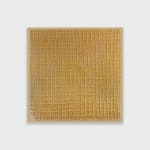


Chancay Culture 1000-1470
34,6 x 34,6 in
Further images
A deftly executed textile panel formed from yellow-orange-dyed cotton threads that are tightly woven to create the hundreds of rectangular compartments as well as loosely woven to form the netting inside each box. The framework is reinforced along the peripheries and interior crossbars to maintain the integrity of the composition and create structural stability for the lattice-pattern lacework. Textile panels like this example have survived throughout the ages due to Peru’s dry, arid climate which aids in preserving the colors and design as well as mitigating mold or decomposition.


